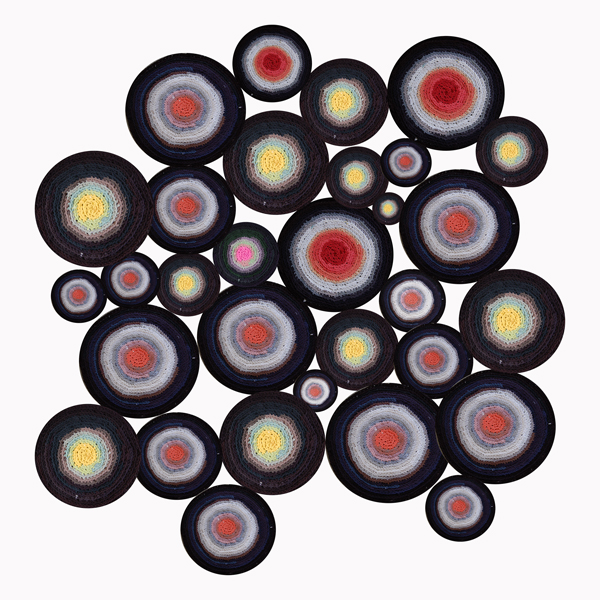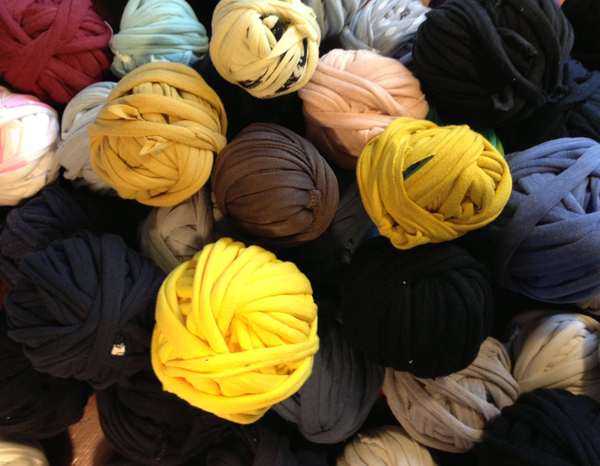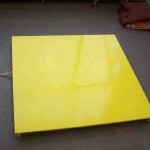Gave the platform for exp.003/2009 a first coat of paint today. Choosing the color was…
Wandering mind
The work to be done: pick, bag, transport, fold, cut, stretch, roll, sort, crochet.
The result is order wrested from disorder – Galaxy.
Spent the better part of 3 days on Galaxy this week, having scored 9 bags of new material last Tuesday. A lot of the work is repetitive, and boring. Which I kind of like, since it sets my mind free to wander. Wandering is something I’ve neither been brought up nor educated to do. My brain has been forged into a precision instrument, and the habit of analysis is deeply embedded in me. I have learned, though, that thinking harder just doesn’t work sometimes. To come up with new ideas, and take decisions about old ones, I need to set my mind to wander. Which I do best under certain conditions: walks, long drives, train rides, napping, doing knitting and crocheting, making yarn. Basically anything that occupies my body without occupying my mind. Also I must be unable to read, write or listen to something – no input, processing or output required. So my brain can turn into itself – weird, no?
To be honest, the habit of analysis never shuts down completely. During the yarn-making activity, two questions surfaced and were processed:
1. why so very few yellow T-shirts?
I need yellow to get close to Starry Night, the van Gogh painting that inspired Galaxy. But yellow T-shirts prove to be few and far between. Now why can this be? Do we not wear yellow as often as we do the other colours? Or is yellow so close to our hearts that we don’t give our yellow shirts up for adoption? Or are the yellow T-shirts treasured at the sorting facility, and fished out of the stream before I get to get at them? To quote one of my former art-school teachers: more research has to be done. In the meantime, please do send me your yellow T-shirts. I need them!

2. what kind of person donates smelly T-shirts?
The majority of T-shirts I process are freshly washed. One or two sweaty T-shirts hide out in every bag I take home though. I put those with the leftovers that I bring back to the sorting facility. They are to be shredded and used for isolation material, for nothing gets wasted at Sort BV in Tilburg. Their reject percentage is between 2 and 3 percent, which is impressive.
Now I did notice that it is usually men’s T-shirts, the smelly ones I mean. Which set me wondering about the psychological dynamics involved.
Two images came up. The first of a woman, standing in front of her wardrobe, deciding that she has Simply Too Many Clothes. So she fills a bag and donates the surplus to charity. Her clothes go into the recycling process freshly washed (and maybe ironed as well). The second image is of a man who’s done a sweaty, smelly, dirty job. The old T-shirt he’s wearing is beyond saving, so it goes into the bin. If he’s extremely environmental-frienldy: the recycling bin.
One conclusion I can draw: my wandering mind is into stereotypes.
Metrics:
– picking T-shirts at Sort BV in Tilburg and transporting them to my studio: 9 bags, 1/2 day
– folding, cutting, stretching and rolling 4 bags: the better part of 2 days
– crochet-ing: 1 day
Results:
– 4 bags of shirts cut, stretched and rolled, resulting in
– 5 bags of yarn for 5 stars, to be distributed to volunteers and
– 5 new stars crocheted by me and
– about 80 balls of yarn yet to be sorted and bagged
– one bag of t-shirts cut into ribbons ready to be cut, stretched and rolled
| « New stars are born | <-- previous post | next post --> | Ambition » |
|---|









